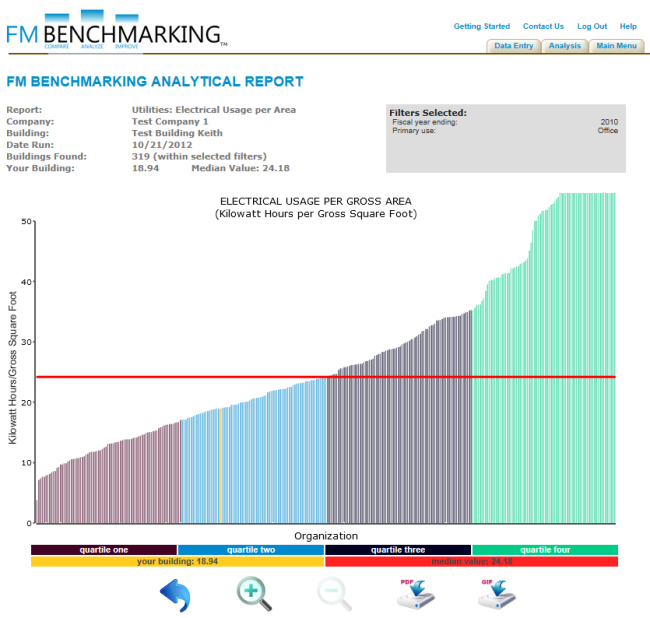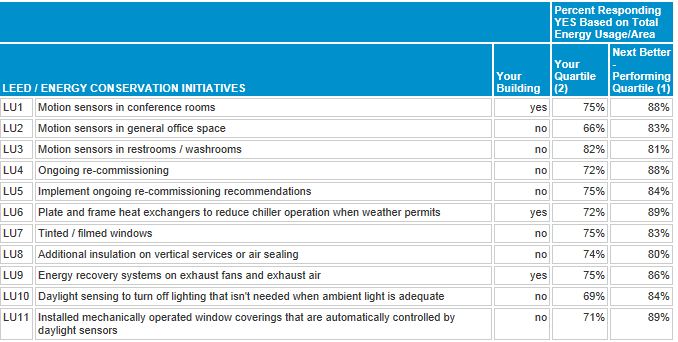If you are in in-house facilities professional for a company that has outsourced its operations, learn what you can request of your contractor to benchmark energy consumption.
In the previous two articles we reviewed examples for maintenance and janitorial services showing why benchmarking for contractors would be beneficial. This month we will continue that same theme and show how trending energy performance will provide opportunities for additional work.
Data that is entered in a benchmarking system can be used to document energy performance. Then the benchmarking results can be used to show areas for improvement that can be used to justify additional projects that would improve the performance of the client’s portfolio.
But how should you begin to collect the information needed to benchmark? Contractors have the same issues getting started with benchmarking as CREs and FMs. Here are some of the often-listed problems with beginning to benchmark and the strategies for dealing with them:
- “Everyone is busy—just getting the urgent work requests completed often keeps the benchmarking initiative from beginning.”
Solution: Assign this work to someone on your staff that can devote the necessary hours to collect and input the data and make completion a priority. After all, this is a business development opportunity. - “Benchmarking appears to be a complex process—it will take a lot of time.”
Solution: Not true—this is a perception! You probably already have most of the data needed to benchmark your client’s energy utilization and costs. All cost and consumption information can be obtained from utility meter data. The gross area and headcount also are readily available information, probably in your files. - “Data may be held by different organizations and, when working for a client, some information regarding space or headcounts may not be readily available.”
Solution: If the client holds any of this information, they would be glad to provide it since you are offering to provide a benchmark comparison. - “Many benchmarking forms are not user friendly so no one usually volunteers to ‘benchmark’ unless they can see the benefits.”
Solution: This may be true for some benchmarking systems but there definitely are “easy to use” systems in the marketplace.
The unfortunate fact is that without good benchmarking comparisons, contractors and their clients may not realize that their energy consumption and costs can be improved. Good comparisons provide opportunities for additional work that contribute to the profit margin on the account. As you can see, a case easily can be made for benchmarking that will justify the minor amount of staff time.
Here is a suggested approach to help you to get started. We have used examples from FM BENCHMARKING to illustrate how easy the process should be; this approach will allow you obtain the key output reports in the minimum amount of time.
First, contractors need to focus on what is important—not everything needs to be benchmarked! For contractors, what is important are the services included in your scope of work. Energy management and facility improvements normally fall under the scope of work for most facilities contractors. Your clients would be glad to see a proposed course of action that would reduce their energy costs. Focus on the KPIs for the major energy metrics that need to be benchmarked.
Two energy KPIs to consider are:
- Electric KWH/Area
- Electric cost/Area
We will look at the benchmarks for these to see if there are opportunities. In Figure 1, we compare our KWH/Area performance to that in other office facilities. This is always a good first comparison since it measures the energy performance directly and takes costs out of the comparison.
This allows you to see at a glance how your facilities compare with other office buildings. There are 319 buildings in this peer group with a median electrical consumption of 24.18 KWH per GSF. Our building is in the second quartile with an electrical consumption of 18.94 KWH per GSF. Not a poor performance but there also is room for improvement. By looking at and comparing similar types of facilities, you will be able to make intelligent “data driven” decisions. This is an opportunity for the contractor to propose some changes to the owner that would improve the cost performance and possibly improve the profitability for the contractor—a win-win for both.

Filters: Type of facility (Office)
Let’s look at the best practices others have implemented so we can generate some ideas that would improve our performance. Since we benchmarked electrical consumption, we will use the “usage-based best practices” (not the cost-based ones—FM BENCHMARKING gives one a choice) to see what others in our quartile and the next better performing quartile have done.
Figure 2 is a partial listing of the best practices implemented by those participants in our quartile and the next better performing quartile. There are actually about 25 best practices in the full table. After looking at just the first few we should consider recommending:
- LU2 — Motion Sensors in the general office space.
This shows a 17% jump in the implementation rate for 1st quartile performance. Motion sensor technology has become more reliable and less expensive to implement. - LU4 — Ongoing Re-commissioning.
This would seem like a very logical first step to identify which systems are not performing to design specifications. In almost any re-commissioning program you will find ductwork that has become disconnected, dampers that have become stuck open or closed, and defective or blocked temperature sensors. The re-commissioning program will identify additional work that can be justified and the benchmarking data supports that this is a good idea.

Filters: Type of facility (Office)
Any owner will require you to justify an expense for a payback. What is the expected cost savings from implementing these types of programs? Let’s go back to FM BENCHMARKING and make a projection of the cost savings.
Figure 3 shows our current benchmarked cost of electricity to be $1.53 per Gross Square Foot. Since our consumption was in the second quartile we obviously are paying a lower than median rate for electricity. Still there is room for improvement. What if we could reduce our consumption 10% by implementing just a few of the best practices ideas? That isn’t a very ambitious target but let’s see what that is worth? A reduction in energy consumption of 10% would translate to a savings of about $0.15 per square foot. Our building size is 1,325,000 square feet so our annual savings is about $200,000. Most organizations will work with a three year payback period so we should be able to self-fund about $600,000 of additional work.

Filters: Primary Use: Office
Conclusions
Using the results from benchmarking, the service provider can make proven recommendations that will reduce energy consumption. A conservative cost savings projection would be about 10% or $600,000 over a three-year period. This is win-win for both the contractor and the owner.
The owner will achieve:
- Electrical cost savings by implementing the best practices recommendations.
- A better performing, more sustainable, facility.
- A self-funded program.
- Improved levels of service or no degradation of service
The contractor will achieve:
- Additional work from projects that will improve the profitability of the account.
- A more satisfied client.
- Identified opportunities for future work.